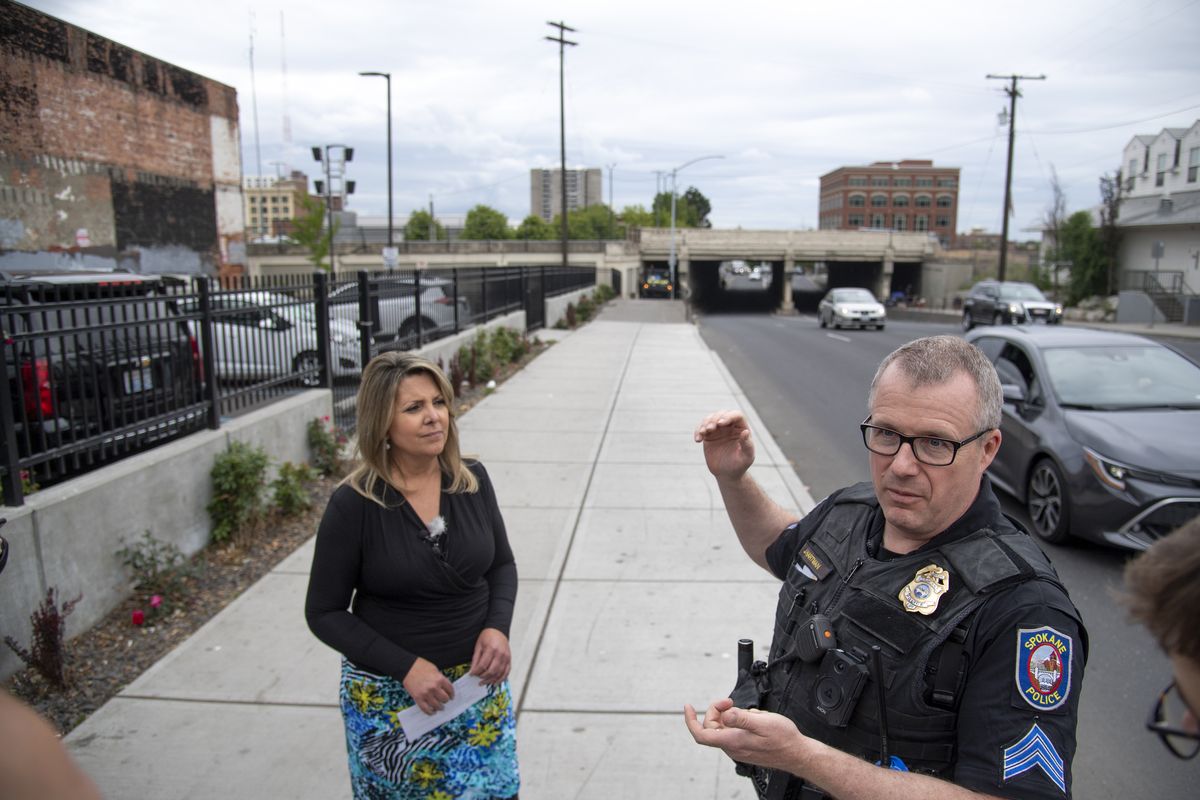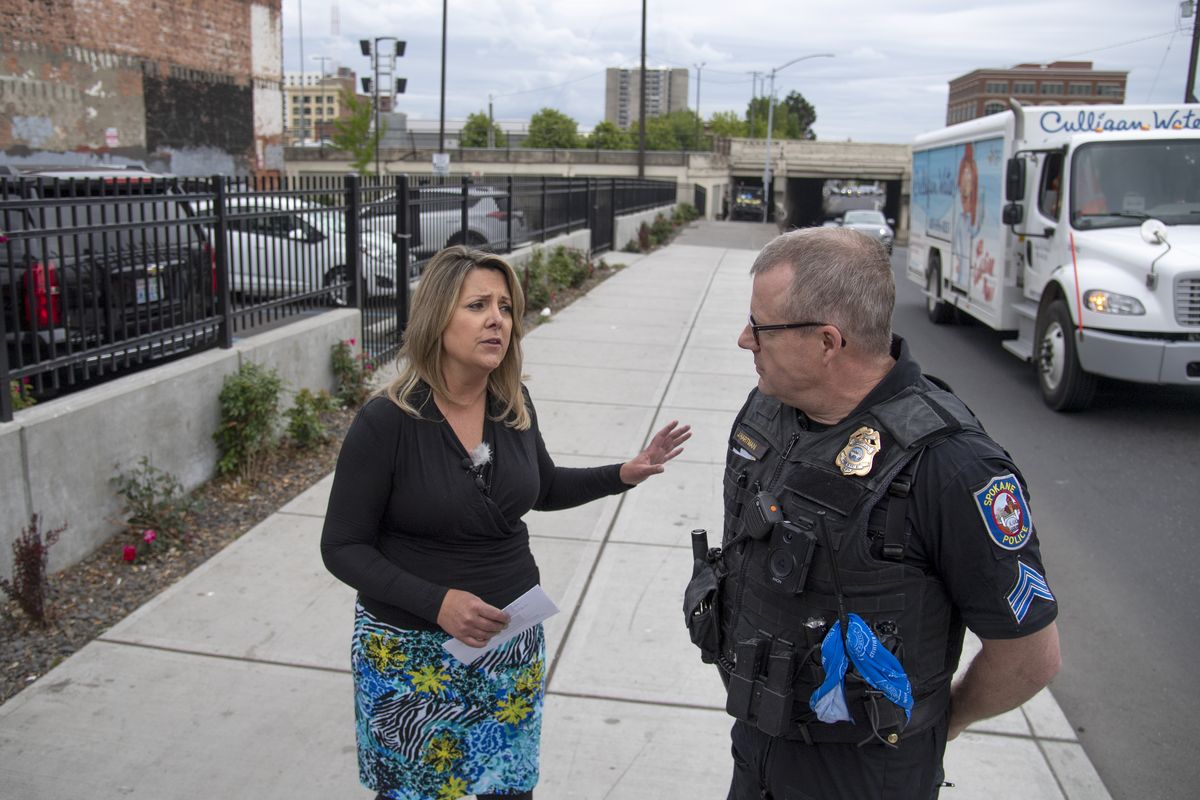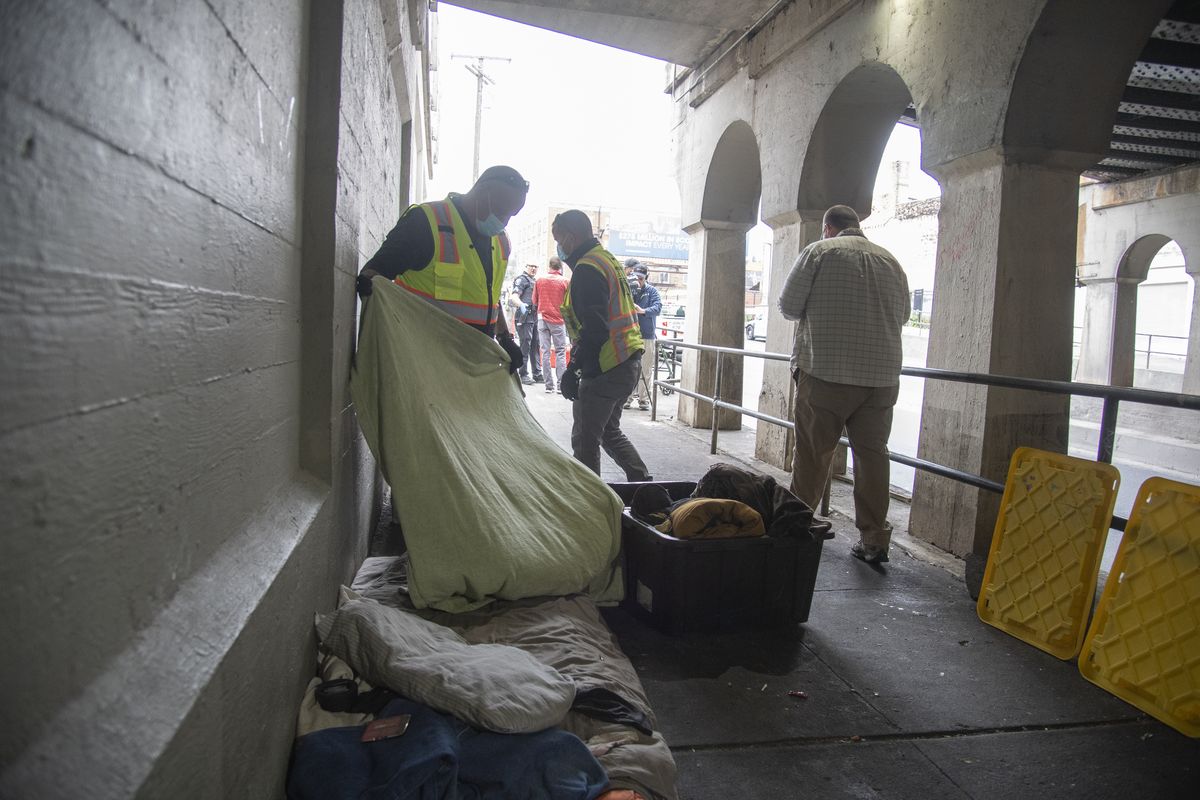Spokane’s homeless shelter system is evolving, but can it keep up with the need?

With the immediate pressures of the COVID-19 pandemic slowly receding, city officials are focusing on a long-term plans for homeless services in Spokane.
Mayor Nadine Woodward is stitching together a network of homeless shelters, touting unprecedented buy-in from regional leaders and increased demand for accountability of some who receive services.
Promises have been made to avoid the sins of years past, in which the city seasonally scrambled to ramp up shelter capacity as cold weather crept into Spokane.
The plan was built as the COVID-19 pandemic interrupted and upended homeless services; federal aid supported shelter operators but also enabled local leaders to make long-term investments in the system.
From this new base, Woodward will begin to implement her vision for the city’s response to homelessness.
Mayor Nadine Woodward and Spokane police Sgt. Jason Hartman talk Wednesday with local media about the city’s clean-up plans for the Browne Street underpass. (JESSE TINSLEY/THE SPOKESMAN-REVIEW)Buy a print of this photo
It’s a “fundamental shift,” Woodward told reporters at one of two news conferences she’s held this month on homelessness.
“That shift has occurred while we simultaneously work together to meet unexpected and constantly evolving pandemic needs, with an eye toward strengthening our system for the long term,” Woodward said.
The approach has drawn scrutiny from some Spokane City Council members who believe central questions still demand answers. Will the city have enough shelter beds to serve its homeless population? Has that population grown during the COVID-19 pandemic? And how will the city replace shelter beds it is losing under the new plan?
“We need a really comprehensive solution,” Councilwoman Lori Kinnear said. “What are we going to do five years down the road? How are we going to address this in a year?”
Spokane City Council President Breean Beggs lauded almost every aspect of the city’s plan, noting much of it has received strong backing from the council. It falls short, he believes, in its scope.
“They’re all good things, I just don’t think they’re nearly enough, and I think most people in the community don’t think they’re nearly enough,” Beggs said.
The system
Woodward’s shelter plan is built on the premise that the city doesn’t need more homeless shelter beds – it just needs to more efficiently use what it already has.
She’s also triumphed the fact that plans were drafted in coordination with leaders from Spokane Valley and across Spokane County.
A new young adult shelter will soon be operated by Volunteers of America. Although its permanent home hasn’t been identified – Woodward initially demanded that it be cited outside the city’s borders but later withdrew that requirement – officials expect it to cover an important gap in the region’s shelter system long highlighted by homeless advocates and the City Council.
It was funded through a $2.7 million state grant applied for and received by Spokane, Spokane Valley and Spokane County, emblematic of the regional effort promised by Woodward.
The city’s warming center on Cannon Street will remain open year-round, operating as a day center with services for the homeless during the summer and as a 24/7 overnight warming center during the winter. Officials have stressed the important flexibility the Cannon Street shelter will provide to the shelter system.
The Salvation Army, meanwhile, will transition its Mission Avenue shelter from night-by-night shelter to a Bridge Housing Program that is intended to serve people deemed ready to transition out of homelessness.
“We’re really not about housing people for the sake of housing them. The bridge shelter is about housing them (and) moving them forward,” Salvation Army Maj. Ken Perine said.
Woodward has spared little expense in mitigating the visible consequences of homelessness to downtown visitors and businesses, promising to double the number of employees dedicated to cleaning up graffiti and waste downtown. Crews will focus particularly on “hotspots,” like under the Browne Street viaduct, conducting regular cleanings.
The city department that will implement this plan is simultaneously facing critical turnover. Tija Danzig, the program manager overseeing homeless services, and Timothy Sigler, the director of Community, Housing, and Human Services, have both left their posts in recent weeks. The city is close to replacing Danzig, but hasn’t recruited for Sigler’s position, according to city spokesman Brian Coddington. Even after the departures, Coddington said, “there’s a good team in place.”
Is homelessness increasing?
Tensions have built in recent weeks between the council and Woodward’s administration over the Point-in-Time Count, the federally mandated annual census of people who are homeless in the Spokane region.
This year’s count was hampered by the pandemic. Under special authorization from Housing and Urban Development, the count only included people sleeping in local shelters. Leaders eschewed a count of people sleeping unsheltered, arguing that it would be impractical and unsafe to conduct it during the pandemic.
Instead, city officials have said that they will lean on other social service data to provide a rough estimate of how many people were unsheltered in 2021. That estimate hasn’t been released.
Even though the count was incomplete in 2021, the administration has cited it as justification for not adding more beds to the system.
“If we utilize the system capacity in a better way, as we’re announcing today, that’s the way to approach it, that’s the way to get more people to exit homelessness,” Woodward told reporters.
According to the preliminary data the city has released, 992 people were counted in city shelters in 2021, nearly identical to the 1,018 identified in 2020.
Beggs and other council members argue that the number is largely a reflection of how many beds the city has available, not how many people are homeless on a given night. Beggs estimates that about 500 people in the city are without shelter on a given night.
The 2020 Point-in-Time Count identified 541 people unsheltered in Spokane, more than 226 more than in 2019 and nearly four times the number counted in 2017.
“That is really stressing not just those people, but the community, so we need a plan for those people, and I think that’s the big gap,” Beggs said.
The number of unsheltered people could increase this year, warned Cupid Alexander, the city’s director of Neighborhood, Housing and Human Services. Generosity extended to those in need during the pandemic by family and friends may not extend after it recedes.
Council members have asked the administration for the Point-in-Time count results for weeks, but the administration withheld them.
Beggs confronted new City Administrator Johnnie Perkins about the numbers during a recent committee meeting, noting that Woodward was briefed on the Point-in-Time Count results in April.
“What’s the difference between the mayor and the council as far as when we get to see numbers, and is that going to continue in the future?” Beggs asked Perkins.
Perkins deflected, stating that “we’re always looking to improve our processes. We’re always looking to improve our forms of communication.”
“I wanted to make sure that I myself was comfortable with the numbers,” Perkins said, adding that he wanted to make sure he was able to “understand what it’s saying before it gets released under my purview.”
Enough beds?
The Way Out homeless shelter is on its way out, but it’s unclear what will fill in for it.
The Salvation Army’s shelter on West Mission Avenue is transitioning to a new model that will establish stricter requirements for its guests, effectively reducing the citywide homeless shelter capacity by dozens of low-barrier beds.
Spokane city leaders do not have an immediate or cohesive plan for replacing The Way Out’s beds, they acknowledged in a meeting of the City Council’s Public Safety and Community Health Committee on Monday.
The Way Out Shelter is operated by The Salvation Army and provides overnight shelter for up to about 100 adult men and women. Its contract to provide night-by-night shelter will expire at the end of June and it is expected to open under a more restrictive model later this fall.
The building’s use as a low-barrier shelter always was temporary and a consequence of the need for extra space during the COVID-19 pandemic. Spokane County purchased the Mission Avenue building using federal coronavirus aid in 2020, with the intent of eventually using it as a bridge shelter.
To cover the resulting loss of beds, the city is asking providers who expanded capacity during the winter to continue to do so, but some are hesitant, according to Alexander. The administration’s approach, he said, has been to “recapture every single bed that we can and extend every contract.”
“The difficulty with this is that even some of the spaces that were used before are either no longer available or the partners are unwilling to allow us to use that space at this time,” Alexander said.
Assuming some nonprofit providers decline to join the city’s efforts, the city will be forced to find a way to add more beds to the system.
One option is to pay for stays at hotels and motels, which the city briefly tested earlier this year when shelter space was stretched thin. At a news conference earlier this month, Woodward did not rule out the continued use of temporary warming centers over the winter.
Beggs noted The Salvation Army has offered to staff another shelter if a building is provided for it. That option is being explored, Alexander said.
Under a new city law passed by the council last year, the administration must present the council with a plan for replacing any lost beds, unless it can show there is no demand for them.
Losing shelter beds during the summer is not atypical in Spokane, where the highest shelter demand occurs during the winter.
But with other providers phasing out winter shelter beds, Alexander noted this will be “one of the first summers where we’re trying to recapture many of those beds so we make sure our unhoused community is stable.”
As it stands, city officials claim the shelter system has plenty of unused beds every night.
“There are consistently 100 or so low-barrier beds available on any given night, so there’s capacity in the system,” Coddington said. “The question the mayor is asking is, ‘How we do a better job as a region … to direct people into those spaces?’ ”
Beggs believes it is obvious that the city needs more beds and a wider variety of shelters. He’d like to see investment in additional bridge housing programs and more shelter capacity for families with children. And if the city opened another low-barrier shelter like its building on Cannon Street, Beggs suspects it would fill up.
The council’s leader welcomes the idea of the city providing a space with platforms for tents and centralized bathrooms, and a similar setup for people living in cars.
To instill accountability, Beggs suggests homeless people be given an ID card. If they access services, such as job training or addiction treatment, they would receive additional privileges.
Enacting such a broad plan to end homelessness would require a “significant infusion of money,” Beggs acknowledges, “as long as you had a path forward through transitional housing and then more permanent housing, you would get there eventually.”





